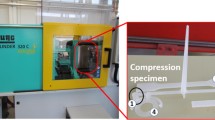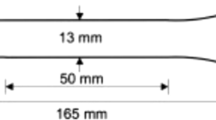Abstract
Polymethylmethacrylate, cellulose acetate butyrate, polypropylene and nylon 6–6 have been characterized in compression at various strain rates from 10−4 s−1 to 103 s−1 at room temperature. A medium strain-rate machine and a split-Hopkinson-bar apparatus are used in conducting the experiments. The temperature rise developed during deformation is also measured by using a thermocouple. All four materials tested definitely show a viscous effect at the beginning of the deformation and a plastic flow follows thereafter. Test results also indicate that the temperature rise developed during deformation cannot be neglected in determining the dynamic response of those materials investigated in this study.
Similar content being viewed by others
References
Percy, J. H. and Meikle, J. B., “The Mechanical Behavior of Polymeric Solids in Compression,” Proc. of Conf. on the Sci. of Mat., Inst. Phys. and The Phys. Soc., Univ. of Auckland, New Zealand (Aug. 1969).
Kolsky, H., “An Investigation of the Mechanical Properties of Materials at Very High Rates of Loading,”Proc. Phys. Soc. 62B:676–700 (1949).
Back, P. A. A. and Campbell, J. D., “The Behavior of a Reinforced Plastic Material under Dynamic Compression,” Proc. Conf. on Properties of Mat. at High Rates of Strain, Inst. Mech. Engineer, Lond., 221–228 (1957).
Ripperger, E. A., “Stress-Strain Characteristics of Materials at High Strain Rates,” U. Texas Contract AT(29-2)-621 (for Sandia Corp.) (1958).
Volterra, E. andBarton, C. S., “An Impact Testing Machine for Plastics and Rubber-like Materials,”Proc. SESA,16 (1),157–66 (1958).
Ely, R. E., “High-Speed Compression Testing of Thermoplastics,”Symp. on Dyn. Beh. of Mat., ASTM Special Tech. Publs. No. 336, 15–33 (1963).
Tardif, H. P. andMarquis, H., “Some Dynamic Properties of Plastics,”Can. Aero. J.,9,205–13 (1963).
Davies, E. D. H. andHunter, S. C., “The Dynamic Testing of Solids by the Method of the Split Hopkinson Pressure Bar,”J. Mech. Phys. Solids,11,155–179 (1963).
Lindholm, U. S., “Some Experiments with Split Hopkinson Pressure Bar,”J. Mech. Phys. Solids,12,317–335 (1964).
Hoge, K. G., “The Effect of Strain Rate on the Mechanical Properties of General Purpose Polypropylene,” Univ. of California, Lawrence Radiation Laboratories, Report UCRL-14316 (1965).
Maiden, C. J. andGreen, S. J., “Compressive Strain Rate Tests on Six Selected Materials at Strain Rates from 10−3 to 104 Inch/Inch/Second,”TR65-26, General Motors Corp., G. M. Defense Research Laboratories, Santa Barbara, CA (1965).
Maiden, C. J. andGreen, S. J., “Compressive Strain Rate Tests on Six Selected Materials at Strain Rates from 10−3 to 104 Inch/Inch/Second,”ASME Trans., Series E, J. Appl. Mech.,33,496 (1966).
Holt, D. L., “The Modulus and Yield Stress of Glassy Polymethylmethacrylate at Strain Rates up to 103 Inch/Inch/Second,”J. Appl. Polym. Sci.,12,1653–1659 (1968).
Dao, K. C. and Percy, J. H., “Polyethylene in Compression at Various Strain Rates and Temperatures,” Inst. Phys. and The Phys. Soc. Conf. Sci. Mat., Auckland, New Zealand (1969).
Meikle, J. B., “Relaxations in Nonequilibrium Glasses,” Inst. Phys. and The Phys. Soc. Conf. Sci. Mat., Auckland, New Zealand, 152 (1969).
Hall, I. H., “The Effect of Strain Rate on the Stress-Strain Curve of Oriented Polymers. II—The Influence of Heat Developed During Extension,”J. Appl. Polymer Sci.,12,739–750 (1968).
Luntz, R. D., “System Control for a Hydraulic (Servo-Actuated) and Pneumatic Medium Strain Rate Tensile Testing Machine,” Dissertation for MS Degree in ME, Univ. of Utah, Salt Lake City, UT (June 1972).
Robertson, K. D., Chou, S. C. and Rainey, J. H., “Design and Operating Characteristics of a Split Hopkinson Pressure Bar Apparatus,” AMMRC, TR71-49 (Nov. 1971).
Clark, D. S. andWood, D. S., “The Time Delay for the Initiation of Plastic Deformation at Rapidly Applied Constant Stress,”Proc. ASTM,49,717–737 (1949).
Campbell, J. D. andMarsh, K. J., “The Effect of Grain Size on the Delayed Yielding of Mild Steel,”Phil. Mag.,7,933–952 (1962).
Jakob, M., Heart Transfer, II, Ch. 33, John Wiley and Sons, New York (1956).
Green, S. J., Griffin, R. M., Black, A. D. andLangan, J. J., “Tri-axial Stress-Strain Response of Polypropylene to High Pressure,”Terra Tek, Inc., Salt Lake City, UT, TR71-24 (July 1971).
Seeger, A., Dislocations and Mechanical Properties of Crystals, John Wiley and Sons, New York (1956).
Author information
Authors and Affiliations
Rights and permissions
About this article
Cite this article
Chou, S.C., Robertson, K.D. & Rainey, J.H. The effect of strain rate and heat developed during deformation on the stress-strain curve of plastics. Experimental Mechanics 13, 422–432 (1973). https://doi.org/10.1007/BF02324886
Received:
Accepted:
Issue Date:
DOI: https://doi.org/10.1007/BF02324886




